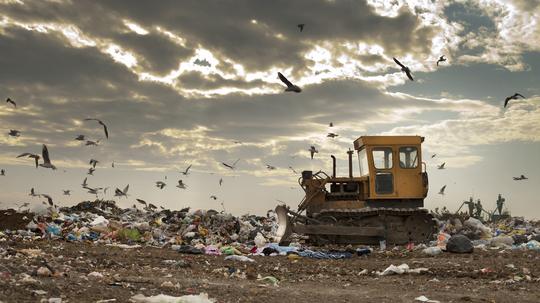
In 2016, California Gov. Jerry Brown signed into law SB 1383, which requires counties and cities to reduce methane emissions associated with solid waste disposal and landfilling by diverting 75% of organic material from our landfills.
Specifically, according to CalRecycle, SB 1383 calls for:
- 50% reduction of organic waste disposal by 2020, 75% by 2025.
- Rescue of at least 20% of currently disposed surplus food by 2025.
This bill was passed to decrease the emissions coming from landfills, which are the third-largest source of methane in California. Roughly 20% of the state’s methane comes from landfills. The focus on methane is because that hydrocarbon has 84 times more impact on the environment than carbon dioxide.
Specifically, SB 1383 focuses on organic waste because approximately half of California landfills are made up of yard trimmings, food scraps, cardboard, and paper that break down into various elements, including methane. The lowest hanging fruit in tackling the climate crisis is reducing short-lived climate super pollutants such as organic waste.
Waste management facilities are vital to this positive and sustainable future and need to respond to SB 1383 targets. They have two core areas of focus:
- Collection and recycling: This year, all jurisdictions will need to have organic waste collection services available to all residents and businesses, and the ability to recycle these organics at their facilities.
- Capacity recovery: Organic waste needs to be diverted from landfills into recycling and food recovery organizations.
In our region, one of the largest waste facilities is the Western Placer Waste Management Authority (WPWMA). It is a “regional agency established in 1978 through a joint exercise of powers agreement between Placer County and the cities of Lincoln, Rocklin and Roseville to own, operate and maintain a sanitary landfill and all related improvements. The WPWMA’s facilities consist of the Western Regional Sanitary Landfill and a Materials Recovery Facility, which includes composting, construction and demolition debris recycling, Household Hazardous Waste, and recycling and buyback facilities.”
Western Placer County is on pace to outgrow its existing solid waste facility capacity due to regional population growth coupled with SB 1383 requirements and changing global recycling markets. Although challenged with capacity, WPWMA is pushing the limits on innovation in the waste facility space and has recently brought on a new Materials Recovery Facility (MRF) operator and is constructing a $120 million facility upgrade, while utilizing the most up-to-date technologies.
The future is circular and collaborative
The Carlsen Center for Innovation and Entrepreneurship and the WPWMA are partnering to establish initiatives and programs to attract, retain, and grow companies and technologies that will utilize WPWMA feed stock to develop new products. By scaling companies and technologies that utilize WPWMA waste streams, they will be able to decrease their carbon footprint and reach SB 1383 climate goals.
“We will have the technology to separate organics as well as other products from within the waste stream, but now need innovation in using recycled materials for new beneficial products,” said Ken Grehm, WPWMA executive director. “It is not enough to pull them from the waste stream. We need innovations to close the loop and reduce our footprint.”
To spur innovation, the partnership is launching a pitch competition that will serve as an on-ramp to attract innovative companies and technologies to WPWMA. This competition is one of the first waste facility crowdsourced idea and technology competitions. It offers innovators a chance to bring their innovations to life through capital, exposure, and mentorship. This competition demonstrates WPWMA’s commitment to the community and region by providing an opportunity for innovators to compete and showcase new innovations.
The Carlsen Center will lead the programmatic efforts and utilize its national reach to attract innovative companies. WPWMA will offer resources such as cash, contracts, space on site, and others, as an incentive for competing companies. The partnership also connects to additional partners, such as Sacramento State’s Sustainability program, which serves as a liaison to researchers on campus as well as interested students.
The long-term vision for the partnership is for it to serve as a leading hub of innovation for the circular economy across the nation.
A Carlsen Center statement offers further insight: “We see this partnership between WPWMA, Sacramento State, and the Carlsen Center as a catalyst for growth and as a signal that this region is serious about sustainability as well as its innovation and entrepreneurial ecosystem.”
For more information, please contact Cameron Law, executive director of the Carlsen Center at Sacramento State.
The Carlsen Center for Innovation & Entrepreneurship at Sacramento State serves as a regional hub and platform for providing approachable and accessible entrepreneurial education, community, and support to enable startup founders of all backgrounds to explore and launch their ventures.
Cameron Law is the executive director of the Carlsen Center, a passionate ecosystem builder, and a proud Sacramento native.
